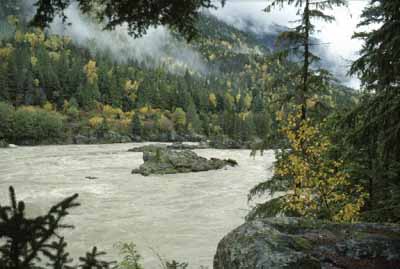Kitselas Canyon National Historic Site of Canada
Kitselas, British Columbia

General view
(© Parks Canada Agency / Agence Parcs Canada.)
Address :
Kitselas, British Columbia
Recognition Statute:
Historic Sites and Monuments Act (R.S.C., 1985, c. H-4)
Designation Date:
1972-10-19
Dates:
-
1800 to 1900
(Significant)
Other Name(s):
-
Kitselas Canyon
(Designation Name)
-
Gitlaxdzok
(Historic Name)
Research Report Number:
2002-SDC/CDE-028, 2002-052, 2007 SDC/CED-039
Description of Historic Place
Located on the banks of the Skeena River on Kitselas Indian Reserve Number One, Kitselas Canyon National Historic Site of Canada is a dramatic natural setting richly endowed with significant cultural resources, such as petroglyphs, totem poles, culturally modified trees, and archaeological remains.
Heritage Value
Kitselas Canyon was designated a national historic site of Canada in 1972. Its reasons for designation are: it encompasses approximately 5000 years of Aboriginal history and is a place of major significance to the people now known as Tsimshian; in the 19th century, two permanent Tsimshian villages occupied a strategic position on the river, giving the people here control over the gateway between the coast and the interior, and therefore control of trade with the Hudson's Bay Company. The fact that Gitlaxdzok was a fortified village site makes it unique on the north coast; and, the cultural record is especially rich and has allowed detailed archaeological reconstruction of the culture history at Kitselas Canyon, including aspects of social change, the lasting relationship with people on the coast, vast trade networks, and changes in settlement patterns.
This location has been settled by Aboriginal peoples for approximately 5000 years. The Canyon is located in a strategic position between the interior and the coast, and for that reason it played a pivotal role in the west coast fur trade. The wealth of surviving material at this site has provided unique and abundant insights into the cultural history of the Canyon.
Source: Historic Sites and Monuments Board of Canada, Minutes, December 2002.
Character-Defining Elements
Key elements contributing to the heritage value of this site include: the location of the site in the Kitselas Canyon of the Skeena River, its strategic value, dramatic natural setting and features; evidence of occupation, including 5 village sites, the petroglyphs, carved poles, cemeteries, grave markers, caches, and surface depressions; surface and below-ground archaeological remains associated with the reasons for designation.